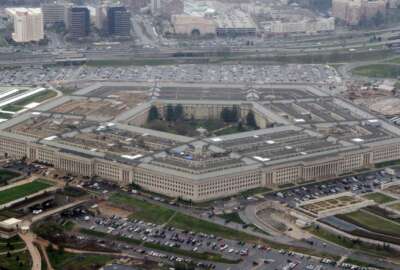

The National Defense Strategy asks DoD to counter near-peer competitors, Iran, North Korea and terrorism.
The Defense Department’s ability to meet the demands of its mission and fight against its perceived threats was a mixed bag from 2017 to 2019, a time period considered crucial to the military’s readiness, and one where the Trump administration pumped billions of extra funds into the Pentagon.
However, some are wondering if the benchmarks for a ready force are overblown due to the Pentagon stretching itself too thin.
A new report from the Government Accountability Office states the readiness in terms of resources grew over a two-year period in most domains: air, land, space and cyber. That means those areas had the required resources and training to conduct missions.
The lone outlier was the sea domain, “The Navy cited limited maintenance capacity at private and public shipyards as the primary challenge for recovering ship and submarine readiness,” the authors of the report state.
In terms of mission capability, DoD did not see the same success. Only the ground domain saw increases in mission capability readiness, which is defined as the ability of a unit to accomplish a task to established standards and conditions. In fact, only five of the 19 force elements and mission areas GAO investigated increased in mission capability readiness.
Mark Cancian, a senior advisor at the Center for Strategic and International Studies, said that may be due to concerns about conducting missions against a highly capable adversary — something DoD is pivoting its attention toward after 20 years of fighting terrorists in the Middle East.
The military started warning Congress in the middle of the 2010s that indiscriminate cuts and late budgets due to the Budget Control Act would affect readiness.
“It is clear the services are still buying back readiness,” a resident fellow at the American Enterprise Institute told Federal News Network. “There’s still work to be done. It is also important to note that the reporting period of 2017 to 2019 does not include this past fiscal year, including the full impact of COVID-19 on personnel and training, and an end to meaningful defense budget growth.”
The Trump administration continued to increase defense funds in 2020 and 2021. The 2022 budget request from the Biden administration proposes a 1.5% increase.
Eaglen added that a challenge for lawmakers is “gaining greater reporting clarity on the relationship between resource readiness ratings and mission capability readiness ratings. When the status of personnel, equipment, supplies and training is improving for certain force elements, but their ability to accomplish designed missions is flatlining or declining, that’s a tension worth examining and understanding in greater detail.”
Lawmakers on both sides of the aisle are wondering about what the Pentagon actually needs in the current threat environment.
The Pentagon’s readiness goals are informed by the National Defense Strategy, which says the United States should be able to fight near-peer competitors while also fighting terrorism, increasing nuclear capability and keeping Iran and North Korea in check.
House Armed Services Chairman Adam Smith said Tuesday that the goals of the strategy are unachievable.
“We don’t have the people to meet that many different needs, to fight that many battles at the same time,” he said at the Ronald Reagan Institute on Tuesday. “We’re sort of perpetually chasing our tail.”
He said the strategy is too big and ambitious in terms of the United States’ needs and the country needs to get back to its core principles of what is necessary and realistic.
Earlier this month, a bipartisan group of 14 lawmakers signed a letter to Defense Secretary Lloyd Austin asking for assistance in balancing the demand signal of combatant commanders against the overdue need for force modernization.
“We have serious concerns that these near-limitless request for forces are driving readiness costs to unsustainable levels, service members and platforms are getting burned through at breakneck paces and much-needed modernization efforts are getting delayed as restricted funds are directed to addressing short-term requirements and risks,” they wrote.
The Pentagon’s response to the letter may cause DoD and lawmakers to rethink what kind of demands the military should respond to and the kind of readiness needed to fulfill it.
Copyright © 2024 Federal News Network. All rights reserved. This website is not intended for users located within the European Economic Area.
Scott Maucione is a defense reporter for Federal News Network and reports on human capital, workforce and the Defense Department at-large.
Follow @smaucioneWFED

